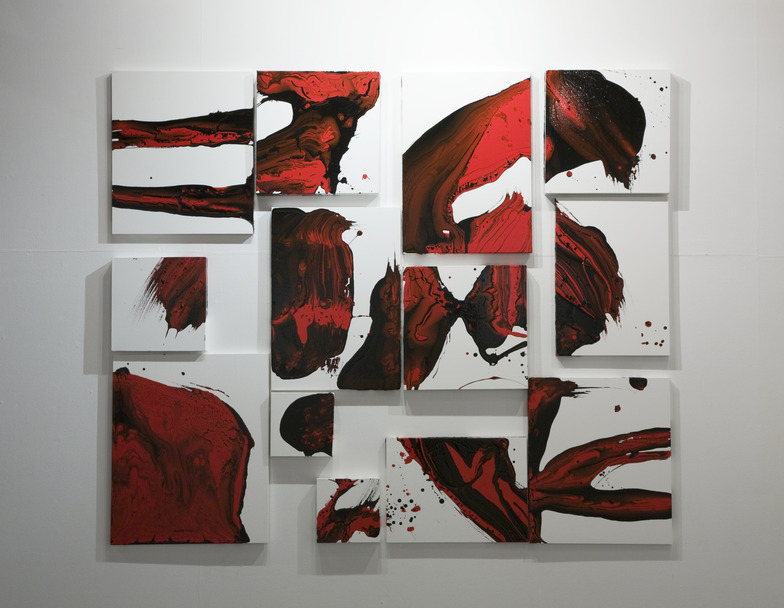Today, I met up with calligrapher Kotaro Hachinohe, who has also been featured on " Warunori Snack," at a Chinese izakaya in Yotsuya. We enjoyed potato salad and plate wonton while drinking delicious Shaoxing wine in a bright, cheerful, and lively atmosphere. Yet, despite drinking a fair amount, my mind felt unusually sharp on the train ride home – likely because Mr. Hachinohe's conversation was so stimulating. Here's a glimpse of what we discussed...

Copywriter Fukuoka and calligrapher Hachinohe
"Do you ever look at calligraphy? (laughs) Japanese people can read kanji or hiragana, right? So when they see a piece, they usually try to figure out what it says. 'What does it say?' That makes sense, but is it a good thing? For example, in New York or London, people who can't read Japanese say, 'But I get it.' What is that about? It's like watching a magic trick: some people enjoy being fooled, while others just want to figure out the trick. Which group is truly enjoying themselves? That's why I did an installation called 'Don't Read, Feel!' (Japanese title: Yomanai de Kudasai). I wanted people to feel the power of the characters directly, without trying to understand the meaning."

Scene from "Don't Read, Feel!"
"I do sessions with musicians and flashy performances, but the foundation for calligraphers is overwhelming rationality. It's a logic you could call 'the study of characters' – 'Make this part shorter, leave space here. This is how you write beautiful characters.' When I was young, I mastered this thoroughly. This 'character science' is the same in China. In Chinese calligraphy, which corresponds to Japanese shodo, they write characters within a grid divided into nine sections, refining precision down to a millimeter. But you know, people who wrote overwhelmingly beautiful characters in their youth by strictly following this logic sometimes unexpectedly struggle to progress further. It's because there's nothing beyond mere beauty there. After all, you can't create truly great work with 'reason' alone."

Hachinohe's work "Resonance vibration"
"What's needed is the unity of 'eye,' 'hand,' and 'mind.' It doesn't necessarily mean each must be one-third, but if any one is missing, it just doesn't work. When I'm in a good flow, it feels like the brush is moving on its own. I'm definitely not writing by thinking with my head. It's like an athlete's 'zone'. Even when I look back later, I have no memory of how I wrote it. It's like the unconscious overrides the conscious. And yet, when I rationally review it later, it's still a proper piece."
"Once, I had to authenticate a piece in a museum's collection. The artist was known as a martial arts master with an unhesitating style. But looking at this work, it was very similar to other authenticated pieces, yet the brushwork showed hesitation. It wasn't written smoothly; something felt off. Ultimately, scientific analysis confirmed it was a forgery. But when you look at the characters, you can sense the speed of the brush and the emotional state of the person who wrote them. Understanding the rational aspects, like 'character studies,' helps you grasp the work more deeply. But even without that, I want people to experience calligraphy more directly—to feel it, not just think about it."

Hachinohe's work "trace"
When I joined Dentsu Inc., my dream was to develop "rational, logical advertising expressions." I believed everything should be clearly structured, that this was the essence of strategy. But over the years, my focus shifted toward how to be truly creative, how to think not just with my brain but with my physical senses. And to be honest, the more seriously I engage with physical thinking, the more I'm stunned by how my own "body" has become dysfunctional.
Even if a piece doesn't resonate at first glance, it suddenly seems brilliant if some authority endorses it. Before being genuinely moved, I catch myself searching for the "right" answer. Take the title calligraphy for "Dentsu Inc. Tsūhō"—I'd never felt anything about it until I got an email from Hachinohe-san saying, "So it was written by Mr. Taion Yanagida! He was one of the superstars of our industry in the Shōwa era. No wonder it has such dignified character." Suddenly, it felt profoundly meaningful.
How to awaken this degenerated "body." That is the enormous, enormous challenge thrust upon me.

The way Mr. Hachinohe's "eyes," "hands," and "mind" are integrated as one.
Now then. October 10th was "Tuna Day." Next time, I think I'll ponder delicious fish in Shizuoka.
Please, enjoy!







